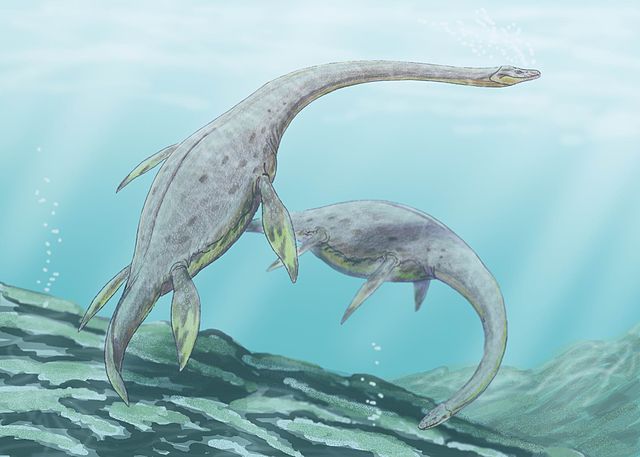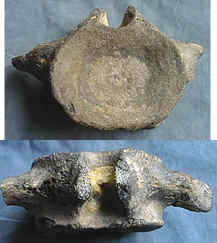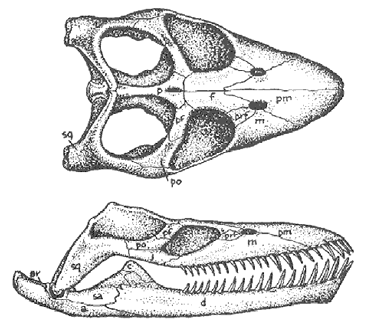
| Palaeos |  |
Sauropterygia |
| Vertebrates | Cryptocleididae |
| Page Back | Unit Home | Unit Dendrogram | Unit References | Taxon Index | Page Next |
| Unit Back | Vertebrates Home | Vertebrate Dendrograms | Vertebrate References | Glossary | Unit Next |
|
Abbreviated Dendrogram
DIAPSIDA |--ARCHOSAUROMORPHA `--LEPIDOSAUROMORPHA |--SAUROPTERYGIA | |--Placodontia | |--Pachypleurosauridae | `--+--Nothosauridae | `--Plesiosauria | |--Pliosauroidea | `--Plesiosauroidea | |--Elasmosauridae | `--Cryptocleidoidea | |--Cryptocleididae | | |--Colymbosaurus | | |--Cryptocleidus | | `--Muraenosaurus | `--Tricleidia `--Lepidosauriformes |--SPHENODONTIA `--SQUAMATA |
Contents
Overview |
 Life reconstruction of the large (length over 5 meters) Cryptocleidid Muraenosaurus leedsi, from the late Jurassic of England (north-central Laurasia). Artwork by Dmitry Bogdanov. Wikipedia, GNU Free Documentation/Creative Commons Attribution |
Cryptocleidoidea: Presumably Cryptocleidus > Elasmosaurus -- not the best name or definition for the stem group, if the idea is to have a monophyletic Elasmosauridae on one side and all other derived plesiosauroids on the other. The problem is that Cryptocleidus may be on the elasmosaur side of that divide. Perhaps a better name would be "Polycotyloidea." Be that as it may, we will again follow Cryptoclidoidea after O'Keefe, 2001 for the present.
Range: Middle Jurassic to Late Cretaceous
Phylogeny: Plesiosauria ::::: Elasmosauridae + * : Cryptocleididae + Tricleidia. ATW020707.
 Cryptocleididae:
Apractocleidus, Aristonectes?, Kaiwhekea, Turneria
Cryptocleididae:
Apractocleidus, Aristonectes?, Kaiwhekea, Turneria
Range: Middle Jurassic to Late Cretaceous, fl Late Jurassic.
Phylogeny: Cryptocleidoidea : Tricleidia + * : Colymbosaurus + Cryptocleidus + Muraenosaurus.
Characters: primitively ~4 m; broad, short skulls; orbit large; narrow vertical jugal bar; deep ventral cheek excavation.occipital condyle formed by basioccipital & exoccipitals and not ringed by a constricting groove; teeth densely packed, thin, interlocking somewhat curved; dentition homodont, with size decreasing distally along tooth row; tooth ornament reduced or absent; premaxilla with at least 6 pairs of teeth (many more in derived forms); primitively 24 pairs of dentary teeth; neck relatively long (29-42 vertebrae); cervical centra not elongated; cervical ribs single-headed; ventral rami of the scapulae relatively broad and meeting in the ventral midline; epipodials broader than long; the fifth metapodial has shifted proximally into the distal mesopodial row; hyperphalangy of up to 15 phalanges in the longest digit.
Note: specialized for "filter- trap" feeding on small, soft-bodied prey (crustaceans, small fish) per Plesiosauria Translation and Pronunciation Guide. This would require some way of forcing the water out to trap the food items against the teeth -- tongue or palatal muscles?
Links: The Plesiosaur Site - Species; Plesiosauria Translation and Pronunciation Guide; Nathis Fauna Reptilelen Mariene Reptielen (Dutch); Scoop: New Species Of Ancient Marine Reptile Named; New papers--New exhibit in London; cryptoclididae; University of Otago Media Release 5 June 2002.
References: Brown (1981). ATW021104.
 Colymbosaurus: Seeley
1874. C. ("Plesiosaurus") trochanterius Owen
1840a.
Colymbosaurus: Seeley
1874. C. ("Plesiosaurus") trochanterius Owen
1840a.
Range: Middle Jurassic (Callovian) to Late Jurassic (Late Tithonian) of Europe (UK). Two incomplete skeletons, postcrania, and teeth from the Kimmeridge Clay (Kimmeridgian) of Dorset, Cambridgeshire, Cambridgeshire and Norfolk, England. Limb elements (juvenile) from the Portland Stone, Dorset, England (late Tithonian).
Phylogeny: Cryptocleididae : Cryptocleidus + Muraenosaurus + *.
Characters: 5-7 m; 42 cervical vertebrae; cervicals amphicoelous, shorter than tall; vertebrae similar in shape & proportions to Cryptocleidus; cervical centra not elongated; 28 dorsal vertebrae; 4 sacrals; 26? caudals; scapula ventral ramus relatively large & plate-like, with convex anterior margin; coracoids meet in the midline in adults; width across posterior cornua of coracoids slightly exceeds the distance across the body between the glenoids in adults; humerus and, to a lesser extent, femur expanded posterodistally, both forming three distinct articular facets (!); there are three epipodials in both manus and pes (!!);
Note: [1] The latest and largest of the Plesiosauroidea known from Jurassic England, it survived right until the very end of the Jurassic, avoiding the mid-Tithonian mass extinction that affected a large number of Jurassic dinosaurs, ichthyosaurs, plesiosaurs, and pterosaurs. [2] The skull and dermal elements of the pectoral girdle are unknown in C. trochantericus, the only decently known species.
Image: anterior and dorsal views of a cervical vertebra of Colymbosaurus sp. from Palaeo Jo's Reptile catalogue.
Links: Plesiosauria Translation and Pronunciation Guide; The Plesiosaur Site - Species.
References: Brown (1981). ATW020707, MAK000218.
 Cryptocleidus:
Seeley 1892. C. eurymerus Phillips 1871.
Cryptocleidus:
Seeley 1892. C. eurymerus Phillips 1871.
Range: Middle Jurassic to Late Jurassic of Europe (UK). Lower Oxford Clay (Callovian) of Oxfordshire and Peterborough, England. Also known from Russia, South America.
Phylogeny: Cryptocleididae : Colymbosaurus + Muraenosaurus + *.
Characters: ~4 m; skull relatively broad, rather lightly built; parietals form sagittal crest; orbits generally directed upward; paroccipital process moderately long; occipital condyle is not ringed by a groove, and extends onto the pedicles of exoccipitals; teeth densely packed, procumbent & intermeshing; tooth ornament reduced; dentary with 24 to 26 tooth pairs; premaxillae with six pairs, of which the first (most anterior) is small and the second to sixth are large; ~55 pre-sacral vertebrae, of which usually 32 are cervical; cervical vertebrae relatively amphicoelous; cervical centra length rarely exceeds height; 4 sacrals; 25 caudals; clavicles triangular & well developed, lie visceral to the ventral rami of the scapulae, and meet in the mid-line; interclavicle absent or rudimentary; coracoids meet scapulae on ventral mid-line in 'adults'; width across the posterior cornua of the coracoids exceeds the interglenoid width in 'adults' by up to 40%; elements of pectoral girdle tend to fuse in old individuals; normally only two epipodials in the manus; a foramen only appears between the epipodials showing advanced ossification; flippers very large.
 C. eurymerus Phillips 1871: teeth retain longitudinal ridges: two opposing
axial ridges (mesial and distal) rise from the base of the crown and almost meet
at the tip, and between them rise 4 to 7 lingual ridges which extend from the
base to approximately one-third of the height of the crown; there are no buchal ridges; humerus greatly expanded distally by an anterior expansion of the
portion bearing the radial facet; radius is enlarged by anterior expansion of
the portion bearing the humeral facet, which may be up to twice as long as the
facet for the radiale, so causing the anterior margin to describe a sigmoid
curve; ulna is much wider than long. [this sounds like Plesiosaurus]
C. eurymerus Phillips 1871: teeth retain longitudinal ridges: two opposing
axial ridges (mesial and distal) rise from the base of the crown and almost meet
at the tip, and between them rise 4 to 7 lingual ridges which extend from the
base to approximately one-third of the height of the crown; there are no buchal ridges; humerus greatly expanded distally by an anterior expansion of the
portion bearing the radial facet; radius is enlarged by anterior expansion of
the portion bearing the humeral facet, which may be up to twice as long as the
facet for the radiale, so causing the anterior margin to describe a sigmoid
curve; ulna is much wider than long. [this sounds like Plesiosaurus]
C. richardsoni: distal anterior portion of the humerus is not greatly expanded; the radius has a concave anterior border, and the humeral facet is only slightly longer than the facet for the radiale; the ulna is approximately square.
Note: [1] A common and well-known Jurassic form, with a relatively short neck with 32 vertebrae. Cryptocleidus is the earliest known member of a distinct line of Plesiosaurs that continue through the late Jurassic, and possibly right until the Maastrichtian (latest Cretaceous). They are never as varied or successful as their elasmosaurid cousins. The neck remains fairly short, similar in fact the early Jurassic plesiosaurs, and the tooth count in the lower jaw remains at 24 pairs (in the elasmosaurids it tends to be reduced), although tooth ornamentation is reduced or absent. [2] from the Plesiosauria Translation and Pronunciation Guide: Cryptocleidus probably fed on schools of soft-bodied cephalopods and small fish, using its many teeth as a filter or trap--its lightly built skull and jaws were not designed to resist strong twisting forces generated by biting or tearing prey. The small size of its external nasal openings and the forward position of the internal nares on the roof of its mouth have suggested to some researchers (Brown & Cruickshank 1994) that its nostrils were not used for breathing, but for "smelling" underwater -- Cryptocleidus would have passed water through the internal nares on the roof of its mouth, then up and out its nose to detect chemical traces of prey.
Links: The Plesiosaur Site - Species; BBC - Walking with Dinosaurs - Fact Files; Plesiosauria Translation and Pronunciation Guide; Cryptocleidus; CRYPTOCLIDUS Dinosaurs Poster; Geology Field Trip Guide - Kimmeridge, Dorset - Kimmeridge Clay Fossils; plesiosaures (French); evolution4; Cryptocleidus; Cat scan of Cryptocleidus centrum; Cryptocleidus; Cynodonte (Portuguese); Cryptocleidus oxoniensis; The Journal of Vertebrate Paleontology; Geology; Museum Laboratory for Geology Students; DinoData Marine Reptiles Plesiosauroidae; Cryptocleidus Printout- ZoomDinosaurs.com; ATW030517, MAK000218.
 Muraenosaurus:
Seeley 1874. M. leedsi Seeley 1874, M. beloclis Seeley 1892.
Muraenosaurus:
Seeley 1874. M. leedsi Seeley 1874, M. beloclis Seeley 1892.
Range: Late Jurassic (Callovian) of Europe (UK & France), perhaps South America.
Phylogeny: Cryptocleididae : Colymbosaurus + Cryptocleidus + *.
Characters: ~5 m (M. leedsi); skull ~40 cm; snout fairly short; a rugose bump anterior to the orbits, dorsal to nares; external nares anterior to internal nares; parietals form sagittal crest; quadrate overlaps quadrate ramus of pterygoid posteromedially; paroccipital process relatively long and slender; occipital condyle ringed by a groove, and is formed by basioccipital only; teeth ornamented with numerous longitudinal ridges; dentaries with 19 to 22 tooth pairs; premaxillae with 5 teeth each, 1st & 5th are small, and others large; anteriormost maxillary tooth (6th upper) small and 8th & 9th large; ~66 pre-sacral vertebrae, of which usually 44 are cervical; cervical vertebrae have relatively platycoelous centra, with length exceeding height in the anterior vertebrae, and >= height in posterior vertebrae; 22-23 dorsals; 4 sacral vertebrae; tail short (24 caudals); body wide; clavicles reduced or absent; interclavicle developed and may be plate-like or reduced and lanceolate; scapulae small compared to coracoids; coracoids meet scapulae at midline in 'adults'; width across posterior cornua of the coracoids is equal to or just in excess of interglenoid width in 'adults'; elements of pectoral girdle tend to fuse in old individuals; limbs short; there are normally only two epipodials in manus; a foramen is present between epipodials [between epipodials or between humeral condyles for the epipodials??] even in juveniles.
Muraenosaurus leedsi Seeley 1874, from the Lower Oxford Clay (Callovian), Peterborough, England ad Calvados area France. Two specimens known of overall length 4.65 and 6.20 m. A well-known Jurassic genus. The neck is very elongate relative to earlier forms like Microcleidus, and contains 44 cervical vertebrae. The head is very small relative to the body, and short and broad. The dentary is armed with 19 to 22 pairs of teeth. The forelimbs are slightly larger than the hindlimbs. Similar forms are known from Russia, Wyoming, and perhaps South America. It is likely that these ocean-going beasts had pretty much world-wide distribution.
 Muraenosaurus
beloclis Seeley 1892, from the Lower Oxford Clay (Callovian), Peterborough, England. This species is known from 4 incomplete
skeletons. Its estimated overall length was 2.5 metres. This is a
small species of Muraenosaurus, distinguished -- apart from much smaller
size -- by a prominent flange on some of the anterior ribs, and details of the
hand (manus) and interclavicle. The neck contains 40 short cervical
vertebrae. It was previously known as Picrocleidus.
Muraenosaurus
beloclis Seeley 1892, from the Lower Oxford Clay (Callovian), Peterborough, England. This species is known from 4 incomplete
skeletons. Its estimated overall length was 2.5 metres. This is a
small species of Muraenosaurus, distinguished -- apart from much smaller
size -- by a prominent flange on some of the anterior ribs, and details of the
hand (manus) and interclavicle. The neck contains 40 short cervical
vertebrae. It was previously known as Picrocleidus.
Note: [1] This genus was classically the flagship of a family including Tricleidus and Colymbosaurus. [2] See also image on Overview page.
Links: The Plesiosaur Site - Species; Digital \I\ Designs - Mesozoic Image - Somewhere Under Tethys (beautiful and technically accurate); Plesiosauria Translation and Pronunciation Guide; plesiosaures (French); forelasning7.pdf (Swedish); ???????? (Japanese and... odd); Dinosaurios- Muraenosaurus.
References: Brown (1981). ATW020708, MAK000218.
| Page Back | Unit Home | Page Top | Page Next |
checked ATW050804
Using this material. All material by ATW is public domain and may be freely used in any way (also any material jointly written by ATW and MAK). All material by MAK is licensed Creative Commons Attribution License Version 3.0, and may be freely used provided acknowedgement is given. All Wikipedia material is either Gnu Open Source or Creative Commons (see original Wikipedia page for details). Other graphics are copyright their respective owners